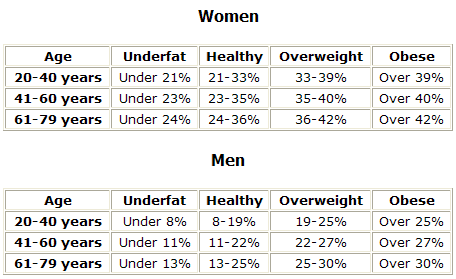In Place of a Road Map: Short N' Sweet
Replies
-
bump0
-
bump0
-
bump0
-
bump0
-
Bump0
-
Bump0
-
Haybales and I should do a radio show.
discuss!0 -
Great...bump for later0
-
Bump0
-
bump0
-
bump0
-
bump0
-
BUMP0
-
Bump!0
-
bump0
-
Bump :drinker: thanks dude0
-
bump - Great post0
-
:flowerforyou: :drinker: :flowerforyou:0
-
bump0
-
Bump.0
-
thank you.0
-
Bump! Great Information!0
-
Saving for reference.0
-
bump- thanks!0
-
BUMP - thank you!!!!0
-
One little issue RE: BODY FAT with the Original Post...
He was use the ACE chart that trainers use.
(bear in mind that Trainers, in part, set these goals because they want to sell you their services.)
The World Health Organization bases there chart on actual HEALTH STATISTICS
(and it take your age in to consideration) 0
0 -
Up you go.0
-
Cheers dude, the bodyfat was the biggest shocker - the 3 calculations were wildly different but averaged out at 35% - cripes.Ad surprise surprise my BMR was more than I've been eating. So gonna bump up to TDEE-20 and see how I go. Thanks for the info and the time you take to answer everyone's queries x0
-
 Bump! 0
Bump! 0 -
The three methods of calculating BF% was a great help. Wow... huge disparity in the 3 numbers. Glad to read others are seeing that as well, so I know that it's not just me doing something wrong.
Thanks bunches for the terrific info. Turns out I need to be eating more. Yikes!0
This discussion has been closed.
Categories
- All Categories
- 1.4M Health, Wellness and Goals
- 398.2K Introduce Yourself
- 44.7K Getting Started
- 261K Health and Weight Loss
- 176.4K Food and Nutrition
- 47.7K Recipes
- 233K Fitness and Exercise
- 463 Sleep, Mindfulness and Overall Wellness
- 6.5K Goal: Maintaining Weight
- 8.7K Goal: Gaining Weight and Body Building
- 153.5K Motivation and Support
- 8.4K Challenges
- 1.4K Debate Club
- 96.5K Chit-Chat
- 2.6K Fun and Games
- 4.8K MyFitnessPal Information
- 13 News and Announcements
- 21 MyFitnessPal Academy
- 1.6K Feature Suggestions and Ideas
- 3.2K MyFitnessPal Tech Support Questions


























